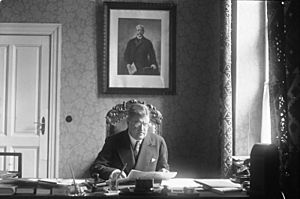Otto Meissner facts for kids
Quick facts for kids
Otto Meissner
|
|
|---|---|

Official Portrait
|
|
| Leader of the Presidential Bureau, later Chief of the Presidential Chancellery |
|
| In office 1 April 1920 – 8 May 1945 |
|
| Preceded by | Rudolf Nadolny |
| Succeeded by | Office abolished |
| Staatssekretär | |
| In office November 1923 – 1 December 1937 |
|
| Staatsminister | |
| In office 1 December 1937 – 30 April 1945 |
|
| Personal details | |
| Born | 13 March 1880 Bischwiller, Alsace, German Empire |
| Died | 27 May 1953 (aged 73) Munich, West Germany |
| Occupation | Lawyer Civil Servant |
| Military service | |
| Allegiance | |
| Branch/service | German Army |
| Unit | 136th Infantry Regiment |
| Battles/wars | World War I |
| Awards | Iron Cross |
Otto Lebrecht Eduard Daniel Meissner (born March 13, 1880, in Bischwiller, Alsace – died May 27, 1953, in Munich) was a very important German government official. He led the office of the President of Germany for a long time, from 1920 to 1945. This period included almost all of the Weimar Republic and the time when Adolf Hitler was in power.
Contents
Early Life and Career
Otto Meissner was the son of a postal worker. He studied law in Straßburg from 1898 to 1903. He also studied in Berlin and earned his law degree in 1908 when he was 28 years old.
After finishing his studies, he worked for the national railroad in Straßburg. From 1915 to 1917, he served in the First World War. He was part of the 136th infantry regiment. Later, he worked behind the front lines as a military railroad official. He was stationed first in Bucharest and then in Kyiv.
In 1918, he joined the diplomatic service. He worked as a German representative to the Ukrainian government in Kyiv.
Working for the President
In 1919, Otto Meissner became an advisor in the office of the German President. The president at that time was Friedrich Ebert. By April 1, 1920, Meissner had become the leader of the Presidential Bureau.
President Ebert promoted Meissner to the rank of State Secretary in November 1923. Meissner continued in this important role under the next president, Paul von Hindenburg.
Changes Under Hitler
When Adolf Hitler came to power, he combined the roles of president and chancellor in August 1934. Meissner's office was then called the "Presidential Chancellery." Its duties became mostly about formal events and ceremonies. Other political matters were handled by a different office.
Meissner also became a member of the Academy for German Law. On January 30, 1937, Hitler gave Meissner the Golden Party Badge. This was given to some non-Nazi government members to mark the fourth anniversary of the Nazi regime.
On December 1, 1937, Meissner was promoted again. He became a Minister of State and the Chief of the "Presidential Chancellery of the Führer and Chancellor." He had a rank similar to a government minister, but without the official title.
After World War II
After the Second World War, the Allies arrested Otto Meissner. He was questioned as a witness during the Nuremberg Trials. In July 1947, he spoke as a witness for another official who was accused.
Meissner himself was later put on trial in the Wilhelmstrasse Trial. However, the court found him not guilty on April 14, 1949. Two years later, in May 1949, he was accused again in Munich. This time, he was found to have been a "fellow traveler," meaning he had supported the Nazi regime without being a member. His appeal was denied, but the case was stopped in January 1952.
In 1950, Meissner wrote a book about his long career as a government official. It was called State Secretary under Ebert, Hindenburg and Hitler. His son, Hans-Otto Meissner, was also a writer.
Meissner's Role in History
Otto Meissner lived with his family in the German president's palace from 1929 to 1939. He had a lot of influence on the presidents, especially Hindenburg.
Historians still discuss his exact role in Hitler becoming chancellor in December 1932 and January 1933. Meissner was close to Hindenburg, so he had some influence. He was involved in talks with Hitler, along with Oskar von Hindenburg and Franz von Papen. These talks led to Hitler being appointed Chancellor.
Meissner tried to resign in 1933, but his resignation was not accepted. After that, his main duties were mostly ceremonial. By 1937, his political influence under Hitler was much smaller.
See also
 In Spanish: Otto Meissner para niños
In Spanish: Otto Meissner para niños


